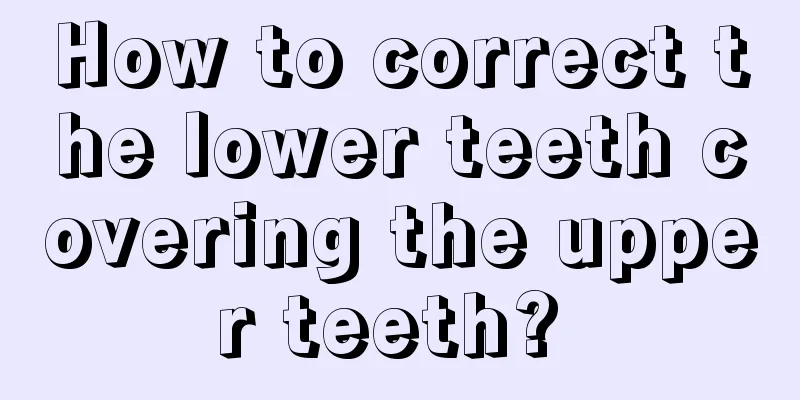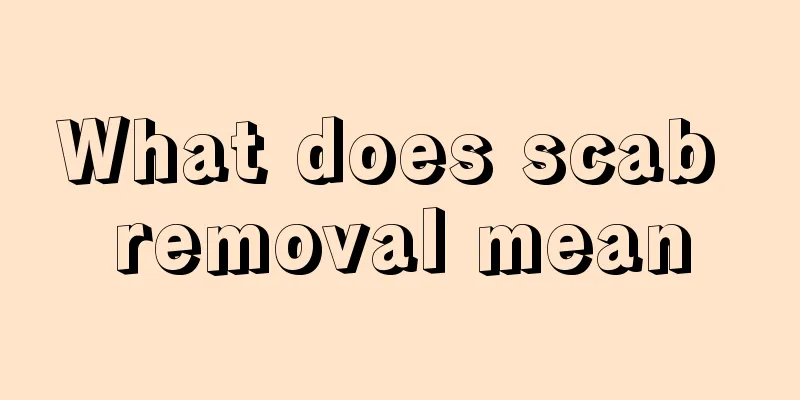How to correct the lower teeth covering the upper teeth?

|
The health of teeth directly affects the health of the body. Good food can be easily absorbed if the teeth are healthy, but if the teeth are not good, the digestion may not be good. Therefore, the health of teeth is very important. The lower teeth covering the upper teeth is called overbite, which is generally divided into two categories. One is dental overbite, which can be corrected, and the other is bony overbite, which is caused by deformity and can be improved through surgical orthodontic surgery. Next, let’s look at the method of correcting the lower teeth covering the upper teeth. 1. Steps Traditional orthodontic treatment is the "iron teeth and steel teeth" correction method we usually see. The correction device is fixed to the teeth with adhesives. Patients cannot take it off or put it on by themselves. It can only be installed and removed and adjusted by the orthodontist. You need to go for a follow-up visit every month, and the doctor will gradually increase the force to move the teeth to the ideal designed state, and the orthodontic work is basically completed. After removing the braces, you will need to wear a retainer for a period of time to consolidate the orthodontic results and prevent recurrence. 2. The effect of simple orthodontic treatment on skeletal overbite is not obvious, and corresponding surgical operation must be performed to achieve satisfactory treatment results. 3. Consult a doctor (you can call or consult online). First, you must determine whether you are suitable for surgical treatment (for example, dentineous overbite does not require surgery), and inquire about prices and other related matters. Learn more about the details, and it is best to consult several hospitals and compare them. Generally speaking, regular hospitals have better quality assurance. 4. Take X-rays of teeth and head bones (panoramic oral film, lateral cephalogram). The purpose is to see the specific condition of your teeth and bones, so as to formulate an accurate surgical plan in the future. 5. To make a dental mold, use a quick-setting glue to put it on your teeth, bite it for 1-2 minutes and then take it out to make a model of your teeth. It is used when formulating the surgical plan and is also for the convenience of comparison during future corrections. 6. The doctor will check your mouth: The doctor will use something to open your mouth to check the situation inside your mouth to see if there is any disease in your mouth to determine whether you are suitable for surgery. 7. Take photos. The doctor will take photos of your teeth from various angles during correction for backup and future comparison. (The only embarrassing thing is that there is a nurse who will stretch your mouth open, exposing such ugly teeth without reservation, and ask you to smile happily in front of everyone. But after you get the braces back from the doctor, there will be a world of difference, and your self-confidence should soar) 8. During the preoperative communication, the doctor will tell you the approximate surgical plan (at this time you need to determine how much alveolar bone you want to recover, depending on your personal preference). 9. During the operation, generally the entire operation is completed within 60 minutes. The operation is performed under local anesthesia. You can feel the doctor moving around next to you. The doctor will talk to you, asking you to clench your teeth, open your mouth, and so on. The surgery is almost over here, and then it’s postoperative care. 2. Diet You can eat some liquid or semi-liquid food at a suitable temperature, such as soup and milk, on the day after the operation, but you cannot rinse your mouth. On the 2nd to 3rd day, you should still drink soup and milk, or some porridge, and rinse your mouth with mouthwash after eating. On the 4th to 7th day, you can eat some food, but you cannot eat anything too hard. Rinse your mouth with mouthwash after eating. The stitches can be removed in 5-7 days (it depends on each individual's situation, generally speaking, they are removed on the fifth day). 3. Notes Return to the hospital for a follow-up checkup within 3 to 6 months and have the fixtures removed. During this period, you can use your teeth normally, rinse or brush your teeth, and maintain oral hygiene. |
<<: How to treat chronic bleeding gums?
>>: Furniture smells? This removes the effect well!
Recommend
How to prevent pancreatic cancer
What are the prevention methods for pancreatic ca...
What are the precautions for inferior turbinate ablation?
The air quality in our daily life is getting wors...
What supplements can elderly people with uterine cancer take
Uterine fibroids are one of the common gynecologi...
Symptoms after being bitten by red fire ants_What are the symptoms after being bitten by red fire ants
Red fire ants not only attack humans, but can als...
How to treat gallbladder cancer in the late stage
The treatment of gallbladder cancer is an issue t...
Symptoms of disinfectant poisoning
Although disinfectants are used to help us disinf...
What causes recurring headaches
People often have headaches while working or stud...
Is the blistering caused by cupping toxic to the body?
Cupping can regulate the body's qi and blood ...
How to increase gastrointestinal motility
Many people have poor gastrointestinal motility. ...
What are the methods to remove mites from quilts
Mites are a type of arthropod that is about one m...
Treatment recommendations for advanced gastric cancer in the elderly
We all know that if we discover a disease in the ...
What to do if warts grow on eyelids
As time goes by, for unknown reasons, red or oran...
Symptoms of psychological obsessive-compulsive disorder, including 5 symptoms of psychological obsessive-compulsive disorder.
I believe everyone is familiar with the disease o...
Is salt harmful to the body?
Food, clothing, housing and transportation are th...
Inflammation of the groin muscles
The groin is the area where the thigh and abdomen...









